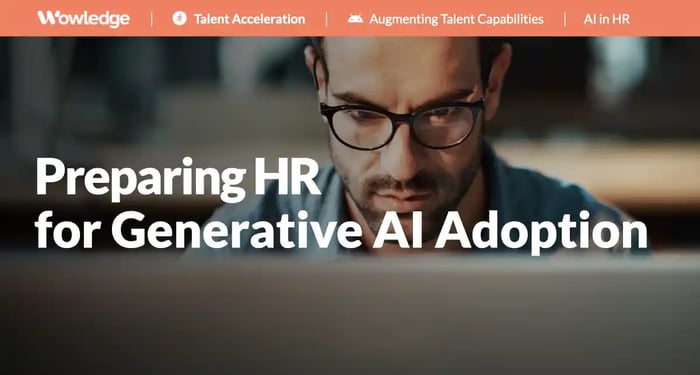Table of Contents
Artificial Intelligence (AI) has transitioned from a futuristic concept to a significant part of daily life, reshaping industries and workflows worldwide. According to SHRM research, approximately 1 in 4 organizations now use AI to support HR-related activities, with many adopting the technology within the last year. Looking ahead, 63% of organizations globally plan to implement AI within the next 3 years. Integrating AI in L&D offers a natural opportunity for such adoption within HR.
Companies, whether they actively incorporate AI or not, face increasing pressure. The LinkedIn Workplace Learning Report reveals that 4 in 5 professionals are interested and eager to leverage AI in their roles. This strong and growing demand for AI knowledge is driving its inevitable integration into the workplace, making it necessary for companies to meet employee expectations.
The growing interest in AI reflects significant changes in the workforce. Rapid technological advancements, changing workforce demographics, and evolving employee expectations are not just pushing but compelling Learning and Development (L&D) teams to rethink their approach. As Millennials (46%) and Gen Z (13%) workers continue to dominate the U.S. workforce, accounting for 59% of the total, traditional learning approaches are no longer sufficient. Digital natives and generations raised with consumer-grade technology expect more from their employers, especially regarding learning opportunities. The L&D teams are now challenged and required to keep pace with the growing demand for more innovative, agile, and personalized learning experiences, making change necessary. Integrating AI in L&D can support the meeting of such challenges.
Meeting the learning needs of digital natives
Digital natives, a term popularized by Marc Prensky, generally refers to two generations:
- Millennials were born between 1981 and 1996. This generation grew up during the rise of the internet and witnessed the shift from analog to digital technologies during their formative years.
- Generation Z are those born between 1997 and 2010. They are considered the first generation to grow up fully immersed in digital technology, never knowing a world without smartphones, the internet, or social media.
These generations are defined by their comfort with digital tools, ease of use, and dependence on mobile devices and online platforms to access information. These technologies have fundamentally changed how they learn and process information.
Digital natives show unique learning preferences compared to older generations. They favor bite-sized, easily digestible content that they can access anytime and anywhere, even on the go. The traditional, one-size-fits-all approach to learning does not resonate with these employees, who prefer engaging, tailored learning that meets their individual needs and preferences.
Additionally, they strongly prefer video-based learning. Short, visually engaging videos that quickly deliver critical information are highly effective, reflecting how these generations consume content on platforms like TikTok and Instagram.
Digital natives, especially Gen Z, also display a great passion for growth and career exploration. A recent report highlights that 53% of Gen Z employees believe learning helps them explore potential career paths within their companies, compared to only 37% of older generations. This emphasizes the need for L&D programs not only for current roles but also for future career aspirations.
One major shift in preferences is the growing importance of personalization. Digital natives expect a high degree of customization in their learning experiences, similar to how platforms like Netflix or Spotify curate content tailored to user preferences. In this context, personalization is no longer a luxury but a standard expectation in L&D.
With personalization comes on-demand learning, where digital natives can access training materials whenever it suits their schedules.
Interactive, hands-on experiences such as simulations, gamified learning, and AR/VR tools are becoming increasingly popular. These provide immersive, engaging ways to learn complex concepts. This shift towards interactive learning models supports higher levels of learner engagement and enhances knowledge retention.

The role of AI in modern L&D
Integrating AI in L&D programs allows organizations to create personalized, engaging, and dynamic experiences that meet the needs of a tech-savvy workforce and align with business objectives. Beyond enhancing the learner experience, AI in L&D can reshape how it functions, empowering its management to focus on strategic initiatives such as career pathways and workforce planning and fostering a culture of continuous learning.
Transformation of a learning culture
Personalization at scale
AI-powered systems analyze learners’ preferences, past behaviors, skill gaps, and performance data to deliver tailored learning experiences. This level of personalization ensures employees receive training aligned with their career aspirations and immediate needs. Examples of AI-powered platforms include Docebo, EdApp, Sana Labs, and 360Learning.
Enhanced knowledge retention
AI allows techniques like “spaced repetition” and “microlearning” to be used, ensuring learners revisit key concepts at optimal intervals. This method, rooted in cognitive psychology, helps strengthen long-term memory retention. Moreover, AI can track performance metrics and adjust training content to reinforce areas where employees struggle, creating an individually based continuous improvement loop.
Virtual coaching
AI-powered virtual coaching offers a scalable way to provide personalized support and guidance to employees, complementing traditional development programs. By analyzing individual performance data, AI coaching tools can identify areas for improvement and deliver targeted, real-time feedback. AI democratizes access to personalized coaching, addressing an ongoing challenge in L&D: how to provide individualized support at scale while effectively tracking employee progress.
Platforms like Coach Hub or BetterUp can identify employees’ strengths and growth needs, assess which would benefit most from coaching, and track their progress. Employees can receive coaching anytime, anywhere, making it easier to integrate into their schedules.
Real-time support
AI-powered chatbots and virtual assistants are valuable additions to modern L&D programs, providing employees with instant support whenever needed. These tools can answer questions, recommend relevant resources, and guide users through training modules, ensuring that help is always available. By making learning materials easily accessible, organizations can foster a just-in-time learning culture that meets the fast-paced environment.
Empowering L&D and HR management through AI
AI not only benefits learners but also equips L&D and HR managers with insights and tools to create a more strategic and efficient learning environment:
Data-driven decision making
AI tools provide actionable insights into training effectiveness, skill gaps, and employee progress. Managers can access real-time data to track the return on investment (ROI) on L&D programs and resources and make informed decisions about future investments. With this data, they can also take a more personalized approach, supporting employees in areas where AI cannot by adding human judgment. This balance of technology and leadership builds trust and fosters stronger connections.
Career pathways
There is a significant shift in employee priorities, with career development climbing from 9th to 4th place on the L&D agenda. AI offers a powerful solution to meet this demand by enhancing the efficiency and role of L&D teams. With AI, L&D teams can create training outlines or even develop entire training programs much faster, freeing up time to focus on strategic initiatives. This enables organizations to scale programs, build robust talent pipelines for emerging roles, and reach more employees with less effort, while maintaining high-quality, targeted learning experiences.
Strategic Workforce Planning
AI can identify specific areas where reskilling or upskilling efforts are most needed, based on market shifts and technological advancements, ensuring organizations remain agile in the face of rapid change. Additionally, by automating operational tasks like tracking training completion or assessing skill gaps, AI frees management to focus on strategic decision-making, such as resource allocation, succession planning, and maintaining a competitive edge in the market.
AI as a strategic partner in L&D
The integration of AI positions L&D not just as a support function but as a strategic partner in driving business outcomes. Here’s how:
Skills-based development
AI enables L&D teams to shift from traditional training models to skills-based development. By leveraging tools like Eightfold.ai or Workday Skills Cloud, which help organizations understand and manage workforce skills, companies can continuously update learning pathways to meet evolving business needs. This approach ensures employees stay competitive and aligned with organizational objectives.
Future-proofing the workforce
AI supports predictive learning strategies by identifying emerging skill trends and proactively preparing the workforce. For example, an organization using AI-driven platforms can predict which skills will become critical over the next 5-10 years, allowing L&D to design forward-looking programs.
Operational efficiency enhancement
AI automates repetitive tasks such as scheduling, tracking progress, and generating reports, enabling L&D teams to focus on higher-value activities like designing innovative programs and collaborating with other business units. This transition enhances L&D’s ability to contribute strategically to business growth.
Integrating AI into L&D enables interactive, on-demand learning that can be delivered more effectively, offering real-time feedback, adaptive learning paths, and instant access to resources. This aligns with the habits of digital natives, who are accustomed to quickly accessing information and continuously updating their knowledge through digital platforms.

How to integrate AI in L&D
Harnessing AI in L&D requires a structured approach that aligns technology with organizational goals and employee needs. Some practical steps enable organizations to integrate AI in L&D strategies to deliver impactful learning experiences and prepare for future challenges. To get started:
Assess the Current State: Evaluate the organization’s existing L&D programs to identify areas for improvement.
- Conduct surveys or interviews with employees to understand their learning preferences and pain points.
- Analyze performance data to identify skill gaps and training programs with low engagement or poor results.
- Compare current training methods against employee preferences and desired business outcomes to determine where AI can add value.
Empower the In-House L&D Team: Ensure the L&D team is equipped to lead the AI transformation.
- Provide targeted training on AI fundamentals and their application in L&D.
- Encourage a culture of continuous learning by hosting regular workshops, sharing industry updates, and sponsoring pilot projects.
- Assign team members to research emerging AI trends and assess their relevance to the organization.
Choosing the Right Tools: Select AI tools that fit organizational needs and the preferences of digital-native employees.
- Research, request, and attend the Vendor’s AI-powered platform demos.
- Involve end-users in the selection process to ensure the tools are intuitive and aligned with their requirements.
- Evaluate potential tools against criteria such as scalability, ease of integration with existing systems, and data security compliance.
Implementing AI: Introduce AI in stages to ensure a smooth transition and minimize disruption.
- Start with pilot programs focused on specific objectives, such as personalized learning pathways or AI-driven virtual coaching. Consider critical workforce segments as targets.
- Use pilot results to gather feedback, measure effectiveness, and refine the implementation process.
- Develop a clear communication plan to keep employees informed and engaged, addressing concerns like data privacy.
- Gradually scale successful pilots to full-scale integration, providing ongoing training and support as needed.
Bringing it all together
Integrating AI in L&D is not just about keeping up with technological advancements. It should focus on fundamentally transforming workforce skill acquisition, retention, and the employee experience. AI shows tremendous potential to empower organizations to build a more dynamic, innovative, and agile workforce by delivering personalized, scalable, and engaging learning opportunities. The trend towards its use is underway, as evidenced by a Gartner study projecting that by 2026, 60% of large organizations will use AI to deliver personalized, scalable learning experiences.
Organizations that leverage AI will effectively future-proof their workforces and create workplaces where employees feel valued, supported, and motivated to thrive.
Relevant Practices & Tools
Advanced Learning and Development Practices to Accelerate Skill and Capability Growth. >
These practices focus on developing, staffing, and managing a learning and development function that is highly responsive to business needs and leverages both technologies... more »
Deploying Emerging Technologies to Boost Learning Content and Delivery for Richer and More Robust Skills Acquisition. >
The latest technologies entering the L&D space are generating attention for their potential to change how learning is delivered to best meet individual needs... more »
Conducting Development Planning to Establish Business-aligned Learning for Each Employee. >
Development planning engages the employee and functional manager in a discussion of individual strengths, ambitions, and work preferences relative to company direction... more »
Defining Career Lattices to Define Robust Lateral and Vertical Mobility. >
The ability to enable the movement of employees proactively and strategically from role to role at the leadership, professional, and operational levels is a key flexibility that advanced... more »
The Individual Development Plan (IDP) Tool: Capture Targeted Employee Learning and Development Actions for a Performance Period. >
A plan of action to guide the employee throughout the coming performance period (e.g., year) as they continue to develop necessary knowledge, skills, abilities, and competencies... more »










